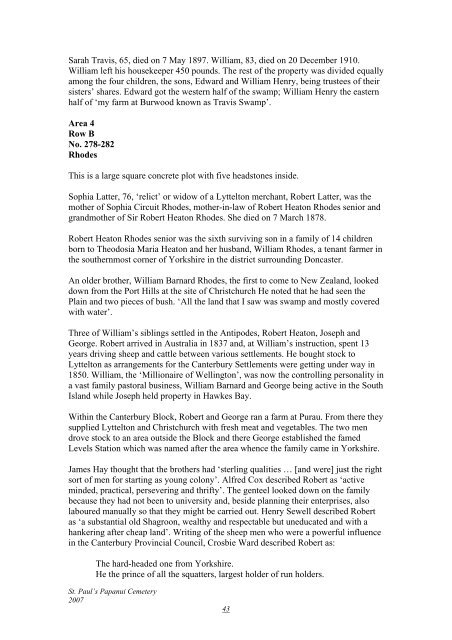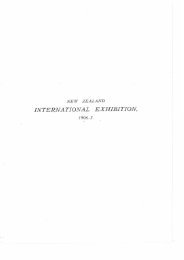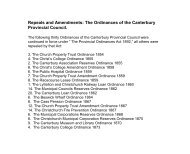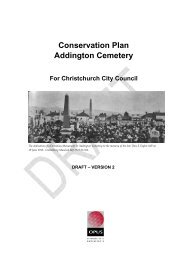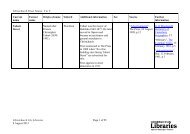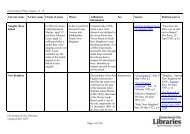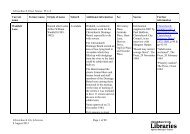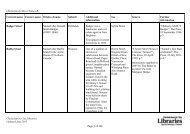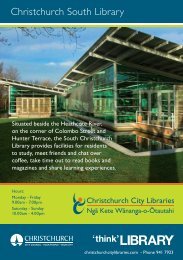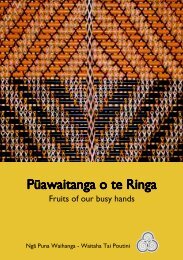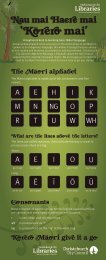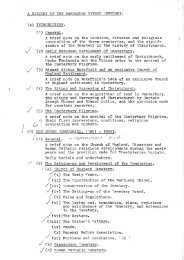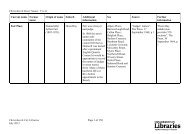St Pauls Papanui Cemetery - Christchurch City Libraries
St Pauls Papanui Cemetery - Christchurch City Libraries
St Pauls Papanui Cemetery - Christchurch City Libraries
You also want an ePaper? Increase the reach of your titles
YUMPU automatically turns print PDFs into web optimized ePapers that Google loves.
Sarah Travis, 65, died on 7 May 1897. William, 83, died on 20 December 1910.<br />
William left his housekeeper 450 pounds. The rest of the property was divided equally<br />
among the four children, the sons, Edward and William Henry, being trustees of their<br />
sisters’ shares. Edward got the western half of the swamp; William Henry the eastern<br />
half of ‘my farm at Burwood known as Travis Swamp’.<br />
Area 4<br />
Row B<br />
No. 278-282<br />
Rhodes<br />
This is a large square concrete plot with five headstones inside.<br />
Sophia Latter, 76, ‘relict’ or widow of a Lyttelton merchant, Robert Latter, was the<br />
mother of Sophia Circuit Rhodes, mother-in-law of Robert Heaton Rhodes senior and<br />
grandmother of Sir Robert Heaton Rhodes. She died on 7 March 1878.<br />
Robert Heaton Rhodes senior was the sixth surviving son in a family of 14 children<br />
born to Theodosia Maria Heaton and her husband, William Rhodes, a tenant farmer in<br />
the southernmost corner of Yorkshire in the district surrounding Doncaster.<br />
An older brother, William Barnard Rhodes, the first to come to New Zealand, looked<br />
down from the Port Hills at the site of <strong>Christchurch</strong> He noted that he had seen the<br />
Plain and two pieces of bush. ‘All the land that I saw was swamp and mostly covered<br />
with water’.<br />
Three of William’s siblings settled in the Antipodes, Robert Heaton, Joseph and<br />
George. Robert arrived in Australia in 1837 and, at William’s instruction, spent 13<br />
years driving sheep and cattle between various settlements. He bought stock to<br />
Lyttelton as arrangements for the Canterbury Settlements were getting under way in<br />
1850. William, the ‘Millionaire of Wellington’, was now the controlling personality in<br />
a vast family pastoral business, William Barnard and George being active in the South<br />
Island while Joseph held property in Hawkes Bay.<br />
Within the Canterbury Block, Robert and George ran a farm at Purau. From there they<br />
supplied Lyttelton and <strong>Christchurch</strong> with fresh meat and vegetables. The two men<br />
drove stock to an area outside the Block and there George established the famed<br />
Levels <strong>St</strong>ation which was named after the area whence the family came in Yorkshire.<br />
James Hay thought that the brothers had ‘sterling qualities … [and were] just the right<br />
sort of men for starting as young colony’. Alfred Cox described Robert as ‘active<br />
minded, practical, persevering and thrifty’. The genteel looked down on the family<br />
because they had not been to university and, beside planning their enterprises, also<br />
laboured manually so that they might be carried out. Henry Sewell described Robert<br />
as ‘a substantial old Shagroon, wealthy and respectable but uneducated and with a<br />
hankering after cheap land’. Writing of the sheep men who were a powerful influence<br />
in the Canterbury Provincial Council, Crosbie Ward described Robert as:<br />
The hard-headed one from Yorkshire.<br />
He the prince of all the squatters, largest holder of run holders.<br />
<strong>St</strong>. Paul’s <strong>Papanui</strong> <strong>Cemetery</strong><br />
2007<br />
43


